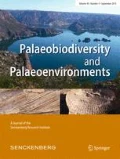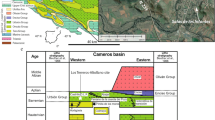Abstract
Early Paleogene mammal faunas from western Asia remain very poorly documented, and the few fossil data currently available raise more issues than they provide answers regarding the palaeobiogeography of the Peri-Tethys area during a key period for the diversification and dispersal of modern group of mammals. Parabunodon anatolicum is an ungulate mammal whose both age and taxonomic affinities are disputable. The holotype of this monotypic genus was collected from the early? Eocene Çeltek Formation, Central Anatolia, Amasya Province, and described as a choeropotamid artiodactyl, making it the easternmost occurrence of the family which is mostly restricted to the middle–late Eocene of western Europe. Here, we revisit the relationships of Parabunodon anatolicum in the light of recent studies. The reassessment of dental features of this genus as well as of its phylogenetic relationships led us to reconsider the taxonomic assignment of this still enigmatic form. Cladistic analysis was undertaken to understand its relationships with the Pleuraspidotheriidae and the Choeropotamidae, in which Parabunodon had earlier been included. Our analysis supports the relationships of Parabunodon with other pleuraspidotheriids. It implies an early diversification and a vast geographic distribution from western Europe to Anatolia of pleuraspidotheriid ‘condylarths’ during the early Paleogene.





Similar content being viewed by others
References
Akgün F (2002) Stratigraphic and paleoenvironmental significance of Eocene palynomorphs of the Corum-Amasya area in the Central Anatolia, Turkey. Acta Palaeontol Sin 41:576–591
Barrier E, Vrielynck B (2008) Palaeotectonic maps of the Middle East. Tectono-sedimentary-palinspastic maps from Late Norian to Pliocene. CGMW/CCGM, Paris
Blumenthal MM (1937) Amasya vilayetine tabi Çeltek’teki linyitli arazinin jeolojik tesekkülati hakkinda rapor. Maden Tetkik ve Arama Enstitüsü, Report No 157
Bremer K (1988) The limits of amino acid sequence data in angiosperm phylogenetic reconstruction. Evolution 42:795–803
Cope ED (1873) On Menotherium lemurinum, Hypisodus minimus, Hypertragulus calcaratus, Hypertragulus tricostatus, Protohippus, and Procamelus occidentalis. Proc Philadelphia Acad Nat Sci 25:410–420
Cope ED (1882) Mammalia in the Laramie Formation. Am Nat 16:830–831
Cuvier G (1822) Recherches sur les ossements fossiles. G Dufour E D’Ocagne, Paris
Depéret C (1908) L’histoire géologique et la phylogénie des anthracothériidés. CR Acad Sci 146:158–162
Ducrocq S, Sen S (1991) A new Haplobunodontidae (Mammalia, Artiodactyla) from the Eocene of Turkey. N Jb Geol Paläont, Mh 1:12–20
Erfurt J, Métais G (2007) Endemic European Paleogene artiodactyls. In: Prothero DR, Foss SE (eds) The evolution of artiodactyls. Johns Hopkins University Press, Baltimore, pp 59–84
Filhol H (1880) Sur la découverte de mammifères nouveaux dans les dépôts de phosphate de chaux du Quercy. CR Acad Sci 90:1579–1580
Gentry AW, Hooker JJ (1988) The phylogeny of the Artiodactyla. In: Benton MJ (ed) The phylogeny of the tetrapods. Clarendon, Oxford, pp 235–272
Goloboff PS, Farris JS, Nixon K (2000) TNT (Tree Analysis using New Technology) (BETA). ver 1.1 Published by the authors, Tucumán, Argentina
Goloboff PA, Farris JS, Nixon KC (2008) TNT, a free program for phylogenetic analysis. Cladistics 24:774–786
Gradstein FM, Ogg JG, Smith AG et al (2004) A geologic time scale. Cambridge University Press, Cambridge
Gümüssu M (1984) Geology of Çeltek (Amasya) coal basin and evaluation of coal potential. PhD thesis, Ankara University, Ankara (in Turkish)
Hooker JJ, Russell DE (2012) Early Palaeogene Louisinidae (Macroscelidea, Mammalia), their relationships and north European diversity. Zool J Linn Soc-Lond 164:856–936
Kappelman JW, Maas MC, Sen S, Alpagut B, Fortelius M, Lunkka JP (1996) A new early tertiary mammalian fauna from Turkey and its paleobiogeographic significance. J Vertebr Paleontol 16:592–595
Karayiğit AI, Eriş E, Cicioğlu E (1996) Coal geology, chemical and petrographical characteristics, and implications for coalbed methane development of subbituminous coals from the Sorgun and Suluova Eocene basins, Turkey. Geol Soc-Lond Special Pub 109:325–338
Karayiğit AI, Gayer RA, Cicioğlu E, Eriş E (1997) Mineralogy and petrography of the two Lower Eocene lacustrine coals, Sorgun and Suluova, Turkey. Int J Coal Geol 34:111–130
Keskin M, Genç SC, Tüysüz O (2008) Petrology and geochemistry of post-collisional middle Eocene volcanic units in North-Central Turkey: evidence for magma generation by slab breakoff following the closure of the Northern Neotethys Ocean. Lithos 104:267–305
Koç C, Türkmen I (2002) Sedimentological characteristics of the coal-bearing Eocene deposits at the north of Suluova (Amasya). Bull Earth Sci Appl Res Hacettepe Univ 26:101–117
Kretzoi M, Kretzoi M (2000) Index generum et subgenerum mammalium. Fossilium Catalogus Animalia 137:1–433
Ladevèze S, Missiaen P, Smith T (2010) First skull of Orthaspidotherium edwardsi (Mammalia, “Condylarthra”) from the late Paleocene of Berru (France) and phylogenetic affinities of the enigmatic European family pleuraspidotheriidae. J Vertebr Paleontol 30:1559–1578
Lemoine V (1878) Recherches sur les ossements fossiles des terrains tertiaires inférieurs des environs de Reims. Ann Sci Nat Reims 8:1–56
Lemoine V (1885) Etude sur quelques mammifères de petite taille de la faune cernaysienne des environs de Reims. Bull Soc Geol Fr 13:203–217
Maas MC, Thewissen JGM, Kappelman JW (1998) Hypsamasia seni (Mammalia: Embrithopoda) and other mammals from the Eocene Kartal Formation of Turkey. In: Beard KC, Dawson MR (eds) Dawn of the age of mammals in Asia. Bulletin of Carnegie Museum of Natural History, Pittsburgh, pp 286–297
Maas MC, Thewissen JGM, Sen S, Kazanci N, Kappelman JW (2001) Enigmatic new ungulates from the early middle Eocene of Central Anatolia, Turkey. J Vertebr Paleontol 21:578–590
Maddison WP, Maddison DR (2010) Mesquite: a modular system for evolutionary analysis. Version 2.75. http://mesquiteproject.org.
Nixon KC (1999) WinClada (BETA) ver 1.00.08 Published by the author, Ithaca, NY, USA
Ozansoy F (1966) Türkiye Senozoik Çaglarinda fossil insan formu problemi ve biostratigrafik dayanaklari. Ankara Univ DTCF Yayinlari 172:1–104
Russell DE (1964) Les mammifères Paléocènes d’Europe. Mem Mus Natl Hist Nat-Paris C 13:1–324
Sen S, Heintz E (1979) Palaeoamasia kansui Ozansoy 1966, embrithopode (Mammalia) de l’Eocène d’Anatolie. Ann Pal 65:73–91
Sudre J, Russell DE, Louis P, Savage DE (1983) Les Artiodactyles de l’Eocène inférieur d’Europe (2). Bull Mus Natl Hist Nat 5:339–365
Tobien H (1980) Ein anthracotherioider Paarhufer (Artiodactyla, Mammalia) aus dem Eozän von Messel bei Darmstadt (Hessen). Geol Jahrb 108:11–22
Acknowledgments
We would like to thank the organisation committee of the congress ‘The world at the time of Messel’. We are grateful to Serdar Mayda (Ege University, Izmir) for taking photographs of the specimen re-interpreted in this paper. G.M. thanks Fabrice Fack for his help with TNT, and all the members of the 2011 field crew that investigated early Paleogene clastics of Anatolia, including the Suluova Basin: KC Beard, Y Islamoğlu, K Sözeri, K Erturaç, Mustapha Koç, K Esat, and A Deveciler. This collaborative project is supported by the MTA-Ankara, the Darius Program, and the Centre Nationale de la Recherche Scientifique-Institut National des Sciences de l’Univers-Interrevie Program. We thank the editor and the referees (J.J. Hooker, and S. Ladevèze) for their constructive remarks on the initial version of the manuscript.
Author information
Authors and Affiliations
Corresponding author
Additional information
This article is a contribution to the special issue “Messel and the terrestrial Eocene—Proceedings of the 22nd Senckenberg Conference”
Electronic supplementary material
Below is the link to the electronic supplementary material.
ESM 1
(DOC 36 kb)
Rights and permissions
About this article
Cite this article
Métais, G., Gheerbrant, E. & Sen, S. Re-interpretation of the genus Parabunodon (Ypresian, Turkey): implications for the evolution and distribution of pleuraspidotheriid mammals. Palaeobio Palaeoenv 92, 477–486 (2012). https://doi.org/10.1007/s12549-012-0095-3
Received:
Revised:
Accepted:
Published:
Issue Date:
DOI: https://doi.org/10.1007/s12549-012-0095-3




